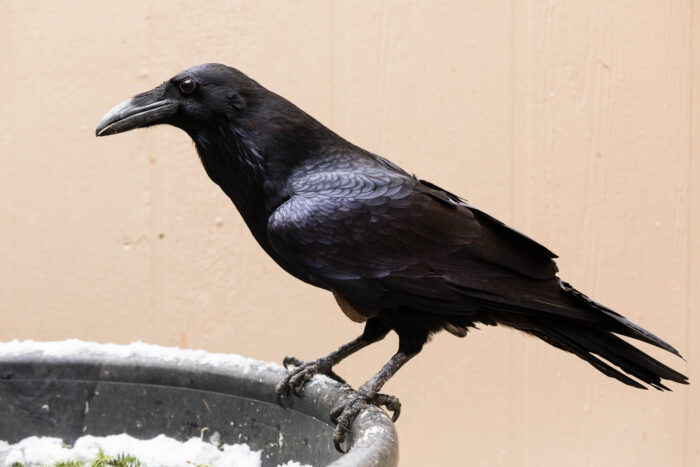Common Raven
Corvus corax
The common raven is an entirely black bird about the size of a hawk. It can be found in New York, Pennsylvania and West Virginia, as well as western Maryland and Virginia.
This section shows one large critter image at a time. Use the thumbnails that follow to select a specific image to display here.

This gallery contains a grid of small thumbnails. Selecting a thumbnail will change the main image in the preceding section.
Appearance
Common ravens are large, entirely black birds with shaggy throat feathers. They are about the size of hawks, growing to between 22 and 27 inches in length with a four-and-a-half-foot wingspan. Often confused with the American crow, the common raven is about one-third larger and has elongated and pointy throat feathers. In flight, it has a wedge-shaped tail. Males and females looks alike, although males are slightly larger.
Feeding
Common ravens are omnivores, meaning they will eat both plants and animals, although they mostly eat animals. They are also scavengers, and will feed on carcasses of dead animals. If they are unsure if something is edible, they will wait to see if another bird eats it and survives.
Predators
Common ravens have few predators, but coyotes, large hawks, eagles, owls, martens and other ravens may attack nestlings. Adults are good at defending their young and will chase predators away.
Flight
Common ravens are known to glide or soar, which they do more often than American crows. They are also acrobatic flyers, and will do rolls or somersaults in the air.
Voice
Common ravens are vocal animals, and have over 20 types of vocalizations for different situations. They have calls for alarm, comfort, chasing, fighting and advertising territories.
Reproduction and life cycle
Common ravens breed and lay eggs between mid-February and late May, with most clutches starting between March and April. Ravens lay between three and seven eggs. After hatching, both parents take care of young, which will stay in the nest for five to seven weeks. Ravens reach maturity at three years of age, and can live to be 13 years old in the wild.
Did you know?
- The common raven is the largest type of songbird.
- Common ravens are extremely intelligent: they will hide surplus food and birds in captivity can recognize their handlers.
- The oldest known common raven lived to be 80 in captivity.
- Young ravens play games with sticks by repeatedly dropping them and diving to catch them in midair.
- By the 20th century, ravens had disappeared from much of the east and Midwest. In recent years, they have expanded their range in the northeast and returned to once-occupied areas.
Sources and additional information
- Animal Diversity Web: Corva corax – University of Michigan Museum of Zoology
- All About Birds: Common Raven – The Cornell Lab of Ornithology
- Guide to North American Birds: Common Raven – Audubon
